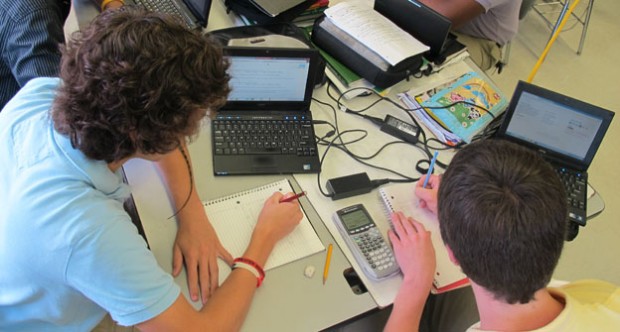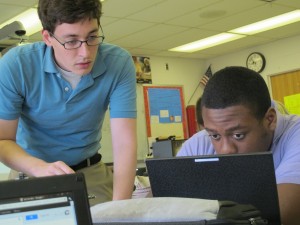How State Dollars Could Fund Your District's Next Tech Initiative

Kyle Stokes / StateImpact Indiana
Sophomores Dylan Woodward (left) and Adam Bennett use their netbooks to finish an assignment in their chemistry class at Evansville's Harrison High School. By the sheer number of devices involved, the Evansville VanderburGet Shortlinkgh School Corporation runs one of the largest "one-to-one" laptop initiative of any district in Indiana.
In some ways, Evansville teacher Brian Bennett’s chemistry class is a lot like any other. Students cluster in groups, solving chemistry equations with pencil, paper and calculator at the ready.
But when students Dylan Woodward and Adam Bennett forget a key part of a formula for a problem they’re working on, the differences become more obvious.
The students don’t flip open a textbook to find the information they need. Instead, they pull up an online video on their netbook computers — provided to them by their school district, and paid for with state dollars.

Kyle Stokes / StateImpact Indiana
Evansville chemistry teacher Brian Bennett assists a student in class. Students access their assignments on their laptops using Google Docs.
—Brian Bennett, Evansville teacher
In 2009, Indiana education officials decided to let school districts to tap into a $39 million pot of state money — previously reserved for textbooks — to pay for digital curriculum and devices for students.
The Evansville Vanderburgh School Corporation saw its chance. The district purchased more than 7,000 netbook computers for its high school students in 2009. The district began giving a netbook to every middle school student at the beginning of this year.
‘Keeping Up With The Joneses’
By the sheer number of devices, Evansville’s “one-to-one” netbook initiative is one of the largest in Indiana. More than 13,000 Evansville students from Grades 6-12 have a school-owned computer to use this year.
“We’re way past a society where knowledge exists in these books that are only updated every six years,” says Jason Bailey, the district’s eLearning director. “There’s so much more out there and it’s at everybody’s fingertips.”
- A Chicken In Every Pot & A Laptop For Every Student?StateImpact Indiana‘s Kyle Stokes visited Evansville’s Harrison High School to see how well one of the state’s most ambitious “one-to-one” student technology programs has been going.Download
John Keller, Assistant Superintendent for Technology at the Indiana Department of Education, says districts are feeding each other’s enthusiasm about digital initiatives. While some districts are motivated to “keep up with the Joneses,” he says, many recognize the growing role of technology in students’ learning experience.
“Kids are going to be learning online and with computers. That’s going to characterize their learning in the future, and certainly in many cases, characterizes it now,” Keller says.
A statewide survey from the beginning of the 2010-11 school year showed that roughly 11 percent of Indiana districts were using the textbook money to pay for a technology initiative. But Keller says, given the buzz he’s heard, those 18-month-old numbers likely understate schools’ interest in classroom technology.
Return On Investment?
Keller says schools need to take steps to ensure new technology is more useful tool than shiny new toy. Teachers need training in using digital curriculum effectively, he says.
Tom Carroll, president of the National Commission on Teaching and America’s Future, agrees. He tells StateImpact:
Purchasing a textbook, which is a huge investment for a district, often turns out to be a bad choice because the content is out of date within a year. You’ve locked yourself into a huge upfront investment in a book that’s out of date a year from now. Online learning resources can be updated constantly and constantly expanded in the content that’s available.
People need to look at those choices very carefully. They can be good choices if people look at the whole package of what it takes to get a good return on investment they’re making — that they’ve supported the teacher, that they’ve matched the tool and the applications on the tool to their instructional objectives and the ability to assess student learning needs.
If they take all of those steps, they get a good return on their investment. If they don’t, people are often disappointed. Too often, it’s been easy to think, ‘We just have to buy the hardware and the problem’s solved.’ That’s not a good solution.
‘Without The Videos, I Couldn’t Do This’
Teacher Brian Bennett says the technology initiative has been great for his classes.
—Jason Bailey, EVSC eLearning director
Bennett has “flipped” his classroom, using online videos to deliver his “lectures” thereby freeing up more time for one-on-one interactions with students in class. (You may remember we wrote about the flipped classroom last year.)
Bennett says the district’s netbooks allow students to have access to every lecture he’s posted whenever they need it, putting interactive reference materials at kids’ fingertips. That means students can work at their own pace and Bennett can assist students who need his personal attention.
The blend of flipped classroom strategies and the netbook initiative is a potent combination, Bennett says.
“I can work with the kids in the moment now, that need my help today. And without the videos, I would be pulled in 15 directions. I wouldn’t be able to do this at all,” he says.
What Keeps Evansville’s Tech Gurus Up At Night

Kyle Stokes / StateImpact Indiana
"Toothless," a student's pet lizard who's lived in Brian Bennett's classroom, climbs on the screen of a netbook during chemistry class.
Evansville district officials have won state grants to provide professional development for schools and help teachers figure out what curriculum out there works.
Still, the district’s netbook initiative has had its share of problems. Many students at Harrison High said the computers are slow and break easily.
Bennett, though, says some students don’t take great care of the computers. In his classes, he says maybe 10 to 15 percent of laptops are out of commission on any given day.
District eLearning director Jason Bailey says the netbooks cost the district more than $2 million per year. But the district is still footing the bill for a lot of textbooks. Bailey says paying both costs at the same time is a growing pain of going digital.
“I think the model becomes more sustainable as we make that shift, as we no longer use those texts and we really embrace that content that’s available on the internet,” Bailey says.
This year, the state’s textbook fund will cover more than 86 percent of the Evansville’s netbook program pricetag. But the state tweaked its rules again and will cover barely 40 percent of Evansville’s costs next year.
Evansville Vanderburgh officials say that change is unfair, since they began paying for the laptops under a different financial arrangement with the state. The district still has two years worth of lease payments left to make.
But Assistant State Superintendent John Keller says what looks like a cut for Evansville is a move to level the playing field for everyone, as more Indiana districts look to the state for technology money.
Podcast: Play in new window | Download
